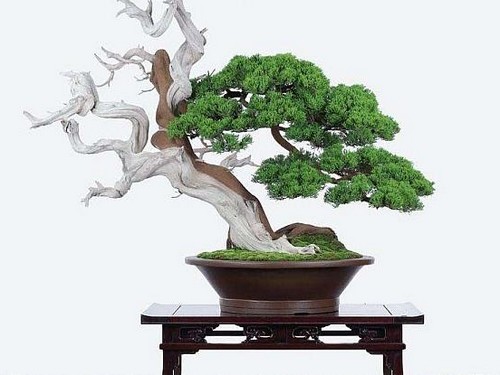Propagation method of wisteria bonsai
Wisteria is a perennial woody vine of the genus Wisteria in Leguminosae. The flower is purple, the florescence is from April to June, the raceme is drooping, the pod is flat, long and ornamental. Wisteria can propagate easily, such as sowing, cutting, striping, splitting, grafting and other methods, mainly sowing and cutting, but because of the long time required for seedling culture, cutting is the most widely used.
1. Wisteria sinensis sowing and propagation:
The root system of sowing seedlings is developed and the resistance is strong, but the seedlings need to go through a long childhood before they can blossom. The seeds of wisteria were collected after ripening in autumn, and the seeds were dried and stored in the sun. Soak the seeds in 80 ℃ hot water for 24 hours before sowing in the next spring, pile up the seeds for 1 day, and sow them in the soil. Or soak the seeds in warm water one month before sowing, then mix sand and put them in the leeward and sunny place to sprout. Before soil preparation, apply sufficient base fertilizer, and apply 5% phoxim granules to eliminate underground pests and pour enough bottom water. Bed sowing or field sowing can be done, row spacing 50~60cm, hole spacing 10-12 m, 2-3 seeds per hole, sowing depth 3~4cm, germination about 20 days after sowing. The amount of seed used per mu was 20~25kg, and 7000000-8000 seedlings were produced.
2. Wisteria cutting propagation:
It is easy to produce adventitious buds on the root of wisteria, so branch and root can be used in cutting propagation. Branch cuttings can be carried out in spring and autumn, selecting 1-2-year-old strong branches, cutting 15~20cm, thick 1~2cm and branches with full buds as cuttings, soaking in clean water for about 4 days, plant row distance 20cm × 30cm, cuttings deep into the soil about 2cm 3, rooting one after another in January, and the survival rate with heel is higher. Root insertion can also be used. After the seedlings are dug before sprouting in autumn or spring, the sturdy lateral roots cut or left in the soil are cut into 10~12cm-long root segments and inserted into 7~9cm in the soil. After survival, the stems can be extracted from the adventitious buds at the top of the root segments. The primary branches of the root cuttings grow weakly and often crawl on the ground, waiting for the branches to grow upright and upward before the seedlings are planted.
3. Wisteria striping propagation:
More than in spring and summer, one-year-old Lignification or sturdy wisteria branches should be selected, cut and treated with auxin, pressing the ground, covering fine soil, and watering moisturizing (ground pressing), or moisturizing wrapped with water moss and moss (high-altitude pressing), which can take root in about 40 days. After it fully takes root, it will be separated from the mother plant in autumn or the following spring and can be planted separately.
4. Wisteria grafted propagation:
The seedlings of this rootstock were grafted, and the superior varieties were used as scions, the abdominal grafting method was used in autumn, the cutting method was used before sprouting in spring or in summer and autumn (from mid-July to early August), and root grafting could also be used in spring.
5. Root-burying propagation of wisteria:
In the middle of March, the thick roots of 0.5~2cm were dug from the nursery or around the mother tree of wisteria, cut to grow the root segment of 8~10cm, and buried in the seedbed according to the row spacing of 35cmX75cm. Be careful not to bury it upside down, and the upper part was buried in the ground.
6. Wisteria leaves roots for propagation:
After raising seedlings in wisteria nursery, part of the root system is often left, which can be used to raise seedlings in situ. The specific measures are as follows: after the seedling is raised, the nursery is slightly leveled, a shallow hoe is used, and basic fertilizer and irrigation are applied, so that a large number of sprouting seedlings can be sent out in spring and carefully managed, and the height of the seedlings in the same year can reach 50~80cm.
Time: 2019-06-12 Click:
- Prev

Pruning and reshaping technique of Pushu bonsai
Pushu is commonly distributed wild in the hills and low mountains and valleys of the Yangtze River basin and its south. It can dig the sprouting old piles of Gucci, which has been cut down for many years, and raise embryos. After pruning, the root system is developed, new branches are sprouted, and then shaped and cultivated, and then processed in the basin after 12 years.
- Next

Modeling method of Chinese pine potted landscape
Glyptostrobus glyptostrobus is known as a living fossil plant, cedar family glyptostrobus deciduous or semi-deciduous trees, this genus is only one species, is the world's remaining plants, endemic species in china. It was born more than 100 million years ago in the Mesozoic era, contemporaneous with dinosaurs. According to plant experts, in Fujian and other coastal areas, if you can find several or even one water pine,
Related
- Fuxing push coffee new agricultural production and marketing class: lack of small-scale processing plants
- Jujube rice field leisure farm deep ploughing Yilan for five years to create a space for organic food and play
- Nongyu Farm-A trial of organic papaya for brave women with advanced technology
- Four points for attention in the prevention and control of diseases and insect pests of edible fungi
- How to add nutrient solution to Edible Fungi
- Is there any good way to control edible fungus mites?
- Open Inoculation Technology of Edible Fungi
- Is there any clever way to use fertilizer for edible fungus in winter?
- What agents are used to kill the pathogens of edible fungi in the mushroom shed?
- Rapid drying of Edible Fungi

